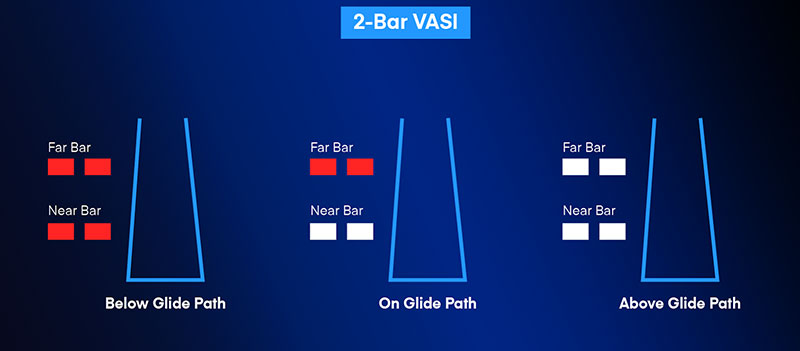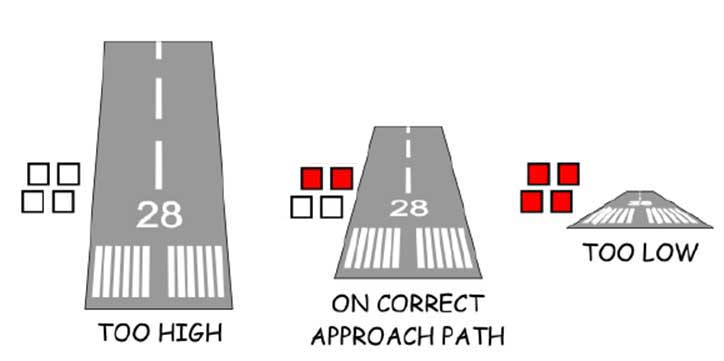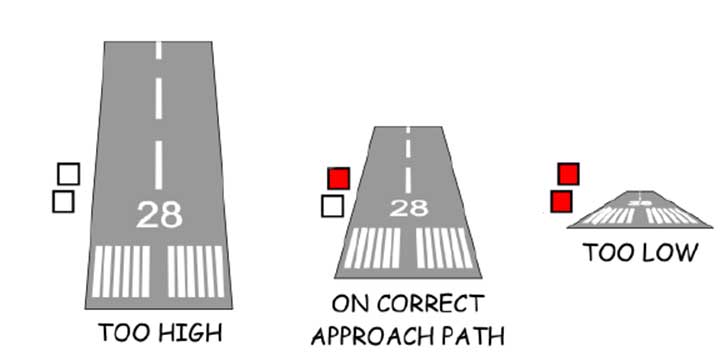Visual Approach Slope Indicator (VASI)
Most VASI installations consist of two bars – near and far. Some VASIs consist of three bars – near, middle and far – which provide an additional glide path to accommodate aircraft with a high flight deck. The lower glide path is provided by the near and middle bars and is normally set at 3°, whereas the upper glide path, provided by the middle and far bars is normally half a degree higher. The two-bar VASI consists of four light units situated on the left side of the runway in the form of a pair of wing bars (two light units per wing bar), sometimes referred to as the upwind and downwind wing bars.


The upper part of the beam shows white while the lower part shows red. When the pilot is:
- above the approach slope, both upwind and downwind bars show white
- on the approach slope, the upwind bar shows red and the downwind bar shows white
- below the approach slope, both upwind and downwind bars show red
- well below the approach slope, the lights of the two wing bars merge into one red signal
The memory aid “red over white, you’re alright!” can be used to recall the correct “on path” indication when using a VASI.
Abbreviated VASI
The abbreviated VASI consists of two light units situated on the left side of the runway in the form of a pair of wing bars (one light unit per wing bar) and its display is similar to that of a VASI.


Definitions
- Abbreviated VASI (AVASI): Consists of two light units situated on the left side of the runway in the form of a pair of wing bars (one light unit per wing bar). The display is similar to that of a VASI and depends on the position of the pilot’s eyes.
- Abbreviated PAPI (APAPI): A precision approach path indicator system consisting of only two light units situated on the left side of the runway. The aircraft is on a slope if the unit nearest the runway shows red and the unit farthest from the runway shows white, too high if both units show white, and too low if both units show red. The APAPI is usually set to an eye-to-wheel height (EWH) of 10 ft (3 m).
- Eye-to-Wheel Height (EWH): The vertical distance from a pilot’s eyes to the lowest portion of the aircraft in the landing configuration is called the eye-to-wheel height (EWH), and this distance varies from less than 10 ft (3 m) up to 45 ft (14 m) for some wide-bodied aircraft, such as the B-747.
- Minimum Eye Height Over Threshold (MEHT): The sum of minimum wheel clearance and eye-to-wheel height of an airplane in the landing configuration.
- Precision Approach Path Indicator (PAPI): A system of lights arranged to provide visual descent guidance information during the approach to a runway. The system is similar to the VASI (visual approach slope indicator). However, the light units are installed in a single row of four light units on the left side of the runway. These systems have an effective visual range of about 5 miles during the day and up to 20 miles at night.
- Visual Approach Slope Indicator (VASI): A system of lights arranged to provide visual descent guidance information during the approach to a runway. Most VASI installations consist of two bars – near and far. Some VASIs consist of three bars – near, middle, and far- which provide an additional visual glide path to accommodate aircraft with a high flight deck.
References
- AIM AGA 7.6.2 – Visual Approach Slope Indicator (VASI) V1 and V2 and Abbreviated VASI (AVASI) AV
- AIM AGA 7.6.4 – Categories According to Eye-To-Wheel Height (EWH) in the Approach Configuration
